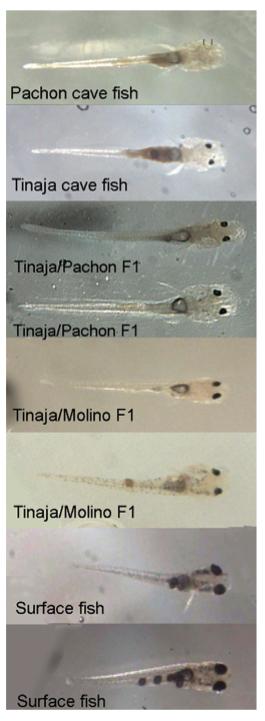tags: researchblogging.org, blind cave fish, Astyanax mexicanus, evolution, fish, genetics
Blind cave fish, Astyanax mexicanus.
Image: Orphaned. Please contact me for proper credit and linkage.
Do you keep tropical freshwater fishes? I have kept tropical fishes for most of my life and was always intrigued by the so-called "blind cave fish", Astyanax mexicanus, that were sometimes offered for sale to the public. These fish evolved from a sighted species that live in surface streams, but since the blind cave fishes lived in caves since the mid-Pleistocene or earlier, they were not exposed to light for at least one million years. Eventually these fishes lost their ability to grow eyes at all because the lack of sight presented no detriment to survival and in fact, because eyes are energetically expensive structures to make, there was selective pressure against their development and maintenance.
But what most hobbyists don't know about these pinkish-white fishes is they actually are comprised of 29 distinct populations found in several caves in north-eastern Mexico (see figure 1).
Why is this so interesting, since all the populations are blind? This is important because some hybrids between different populations have had their sight restored in just one generation, according to a study that was just published.
Earlier research revealed that blindness in blind cave fish was the result of mutations at distinct locations, or loci, on the suite of genes that are responsible for making a fully functional eye. Further, this previous work showed that each population of fish had mutations at different loci, so they were blind for different genetic reasons. Based on this information, Richard Borowsky, an evolutionary biologist at New York University, hypothesized that genetic mutations found in separate populations might complement each other so that partially or fully functional eyes would be restored in the hybrid offspring.
"Given the large number of mutations at different loci that have accumulated in these populations, we reasoned that hybridization among independently evolved populations might restore visual function," Borowsky said.
 When blind cave fish development was observed, all embryos began developing eyes but these structures rapidly diminished into vestigial organs as the animal aged in purebred individuals (see Pachon cave fish and Tinaja cave fish, figure 2). The fish's body then grows skin and scales over them. Further, not only were the fishes' eyes affected, but the muscles required to move the eyes along with the brain structures necessary to interpret incoming visual information were affected.
When blind cave fish development was observed, all embryos began developing eyes but these structures rapidly diminished into vestigial organs as the animal aged in purebred individuals (see Pachon cave fish and Tinaja cave fish, figure 2). The fish's body then grows skin and scales over them. Further, not only were the fishes' eyes affected, but the muscles required to move the eyes along with the brain structures necessary to interpret incoming visual information were affected.
However, the hybrid embryos (Tinaja/Pachon F1 and Tinaja/Molino F1, figure 2) developed fully functional, although smaller than normal, eyes (see surface fish, figure 2, for comparison).
Interestingly, the resulting hybrids demonstrated that this complementation depends upon the genetic distinctiveness of each population: when two nearby populations of fish were hybridized, they produced fewer sighted offspring than did those that were more distantly located from each other. This implies that there is a connection between nearby caves that allows some gene flow so these nearby fish populations share some of the same mutations.
"Restoration of the ability to see comes in a single generation because the populations residing in different caves are blind for different reasons -- [for example] different sets of genes are non-functional in the different populations," said Borowsky. "[In the hybrids], the deficiencies in one lineage are compensated for by the good gene copies in the other lineage, and vice versa."
Borowsky plans to study these fish further to identify the actual genes responsible for blindness. Such research will likely contribute to identifying the genetic causes of human blindness and vision problems, such as myopia and macular degeneration.
Equally as important, this research adds insights into the evolution of cavefish in particular, and also serves to illustrate a general evolutionary principle: there is more than one molecular mechanism to accomplish the same result.
"Evolution's palette is varied," Borowsky asserted. "There are numerous genetic ways to accomplish the same change."
This study was published in the peer-reviewed journal, Current Biology.
Sources
R BOROWSKY (2008). Restoring sight in blind cavefish Current Biology, 18 (1) DOI: 10.1016/j.cub.2007.11.023.
National Geographic (quotes, photograph)
- Log in to post comments



Cool stuff. Follow up reading? I recommend the two papers on albinism by Protas et al. (2007). Tabin lab (HMS). The PubMed IDs are 16341223 and 17306543.
What a cool bit of research...thanks for the post. A couple of comments, though.
Well, the mutations aren't actually debilitating, are they? In this case they're adaptive.
I'm not a biologist. Any ideas about which genes these might be? Could it just be a mutation in regulatory DNA controlling when and where the eyes were to be expressed?
Is that necessarily true? I'm always skeptical of researchers making claims about research relating directly to human diseases or ailments. Why not hedge the bet a bit and say "may also contribute"?
Anyway, good stuff.
As I understand it, the blind fish are actually more closely related to the local surface fish than to other populations of blind fish. This is supported by the fact that loss of eyes is the result of different mechanisms in each population.
I wondered about the statement that the complementation was less strong when the fish were from nearby populations. They said that this was probably because of a connection between these populations. Could it not also be that they were descended from the same surface stock, and some part of their genetic makeup predisposed them for a particular regulatory change?
Derek James said:
"Could it just be a mutation in regulatory DNA controlling when and where the eyes were to be expressed?"
I would say that is almost certainly the case. OTOH, I'm not a real scientist, I just play one in front of my high school students. :-)
you are correct about the use of "debilitating" .. i removed that word.
i am a biologist, but i am not sure precisely what these genes might be, and i suspect that most other biologists do not, either. i am sure that some of these genes have been identified, but i doubt they all have, or even that a majority have been identified. however, this being the internet, i am sure a vision expert will pop in here and provide the correct information.
these mutations CAN be in regulatory genes, which can knock out an entire suite of genes, but they also can be found in single genes further downstream in the pathway, thereby knocking out particular gene products, instead. it is likely that these mutations are probably found in both regulatory genes and in the downstream suite of genes; i do not know of a genetic mechanism that would "predispose" particular populations of fish to manifesting particular genetic mutations. maybe you can describe what you mean in more detail since i think i might be misunderstanding what you mean?
yes, i was bold to say that this research WILL contribute to research relating to human diseases or ailments (and i wouldn't be so bold in a scientific paper), but the fact is that particular sorts of genes, especially regulatory genes, are well conserved across a large number of taxa, meaning that they are found in such a vast variety of animals ranging from fruit flies to humans, that such research DOES contribute to our understanding of human diseases and ailments.
thanks for your comments, everyone.
This is so cool, because it's such a wonderful demonstration of the messiness of evolution at the genetic level.
On the genes, they mention in the paper that in one cross, they found 12 QTLs (Quantitative Trait Loci), i.e. they could relate 12 regions of the genome with the eyeless phenotype. But they didn't have any idea what the genes are, and actually they might not be genes, but just regulatory regions. More work needs to be done etc.
Bob
One point that I think isn't quite spelled out here - and I'm no biologist, either, so consider the source - is that once the fish has lost sight, and those energy-expensive organs, the pressure to further degrade the eye-creating pathways is lifted. So it's reasonable that each species would acquire one such mutation and then stop - although the pressure in light-inhabiting species to preserve that mechanism is also missing, so a higher rate of unselective mutations to those pathways would be expected. But I imagine that rate would be far below the selection-pressured rate, which leaves us with mutation counts small enough that hybridization can compensate. Neat stuff.
Why is this so interesting, since all the populations are blind? This is important because some hybrids between different populations have had their sight restored in just one generation, according to a study that was just published.
Wow, that's amazing. Just one generation to reverse all that time!
Dave Briggs :~)
Eventually these fishes lost their ability to grow eyes at all because the lack of sight presented no detriment to survival and in fact, because eyes are energetically expensive structures to make, there was selective pressure against their development and maintenance.
I doubt the energetic expense is much of a factor. Probably more significant is that eyes are delicate structures and very susceptible to injury and infection. That's why these fish also grow skin and scales over their vestigial eyes.
We've just had some threads over at the Richard Dawkins forums on this (and in one of them, Grrlscientist is duly linked!).
However, I'd like to point everyone to this link, which links in turn to downloadable PDF papers from various journals written by workers in the field. (Sadly the Nature article about shh and twhh genes is a paid subscription article only, but I linked to the other papers in the case of the freely downloadable ones).
Apparently, another development of interest is this: if you transplant the proto-lens disc from a surface dwelling (and normally sighted) Astyanax mexicanus to an embryo of a cave dwelling Astyanax mexicanus, again, near-normal functioning eyes develop in the ensuing fish.
i am very thank full that due to this web page i am able to find research about blind cave fishes
I've had albino c.f. years ago, now my {last of a pair} seem to be dying of old age,, neat somewhat blundering with others type fish docile and neat.. These last two both ended up with s shaped curvatures of their spines..for the last 2/3 years, didnt seem to bother them, wtf is that all about? The last one is at least 6 yrs old, 5 inches and 2 deep and always in motion. :) :) :(..